Qualitative Techniques and Research Design for Psychologists
VerifiedAdded on 2019/09/20
|28
|6891
|833
Report
AI Summary
This report delves into qualitative techniques and research design within psychology, specifically focusing on the study of friendship. The research employs a qualitative approach, utilizing thematic analysis and interpretative phenomenological analysis (IPA) to explore the subjective experiences of individuals in relation to friendship. The study involves a semi-structured interview with a participant, Trevor, who discusses his experiences with friendship, highlighting the different facets and complexities of relationships. The report outlines the research question, methodology, data collection methods, and the process of analysis, which involves identifying key themes from the interview transcript. Findings reveal that real friendships bring joy, while superficial friendships can lead to disappointment. The analysis highlights the importance of examining friendships during difficult times. The report concludes that friendship has various dimensions and is tested during difficult phases of life, with some friends being more like family while others are not.
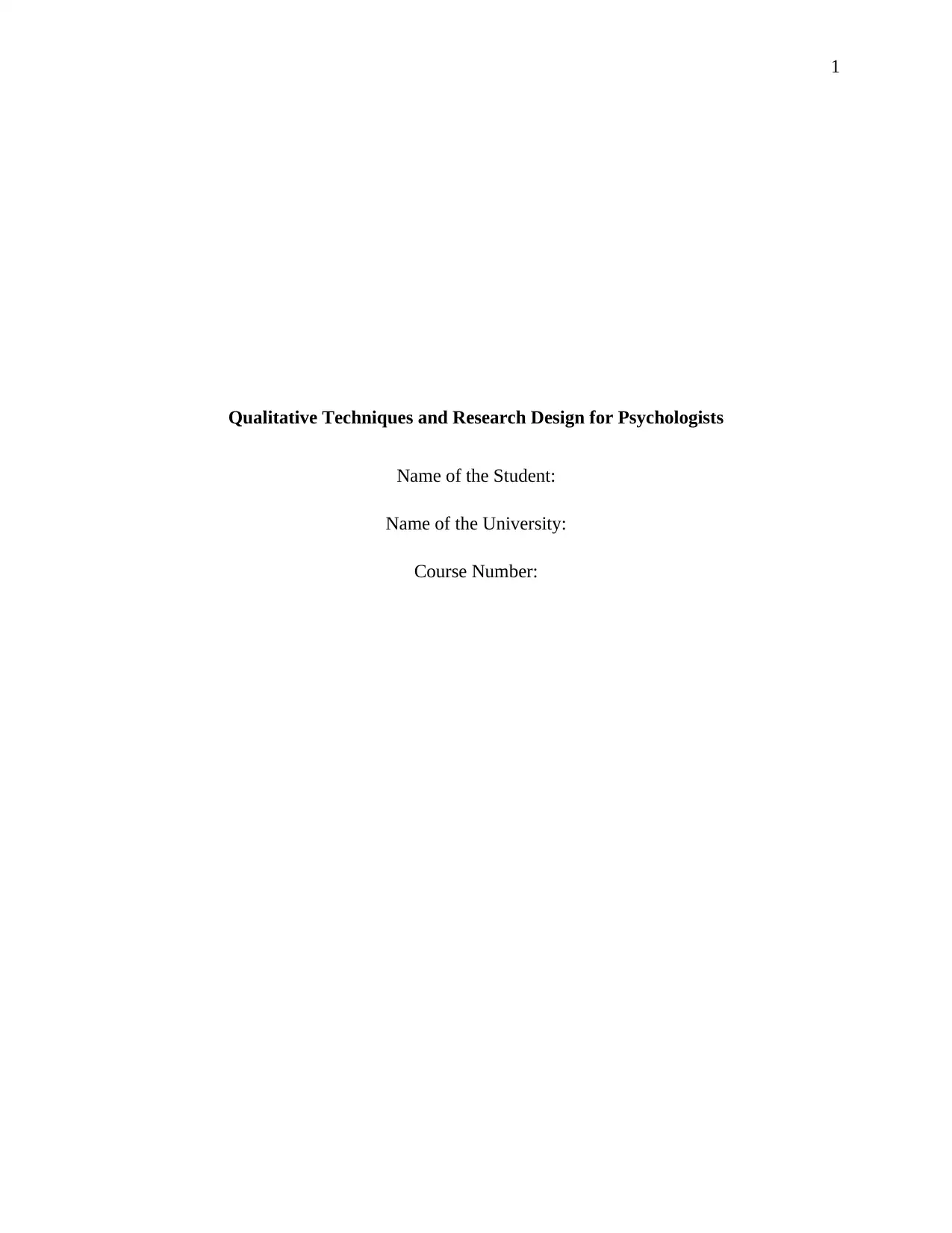
1
Qualitative Techniques and Research Design for Psychologists
Name of the Student:
Name of the University:
Course Number:
Qualitative Techniques and Research Design for Psychologists
Name of the Student:
Name of the University:
Course Number:
Paraphrase This Document
Need a fresh take? Get an instant paraphrase of this document with our AI Paraphraser
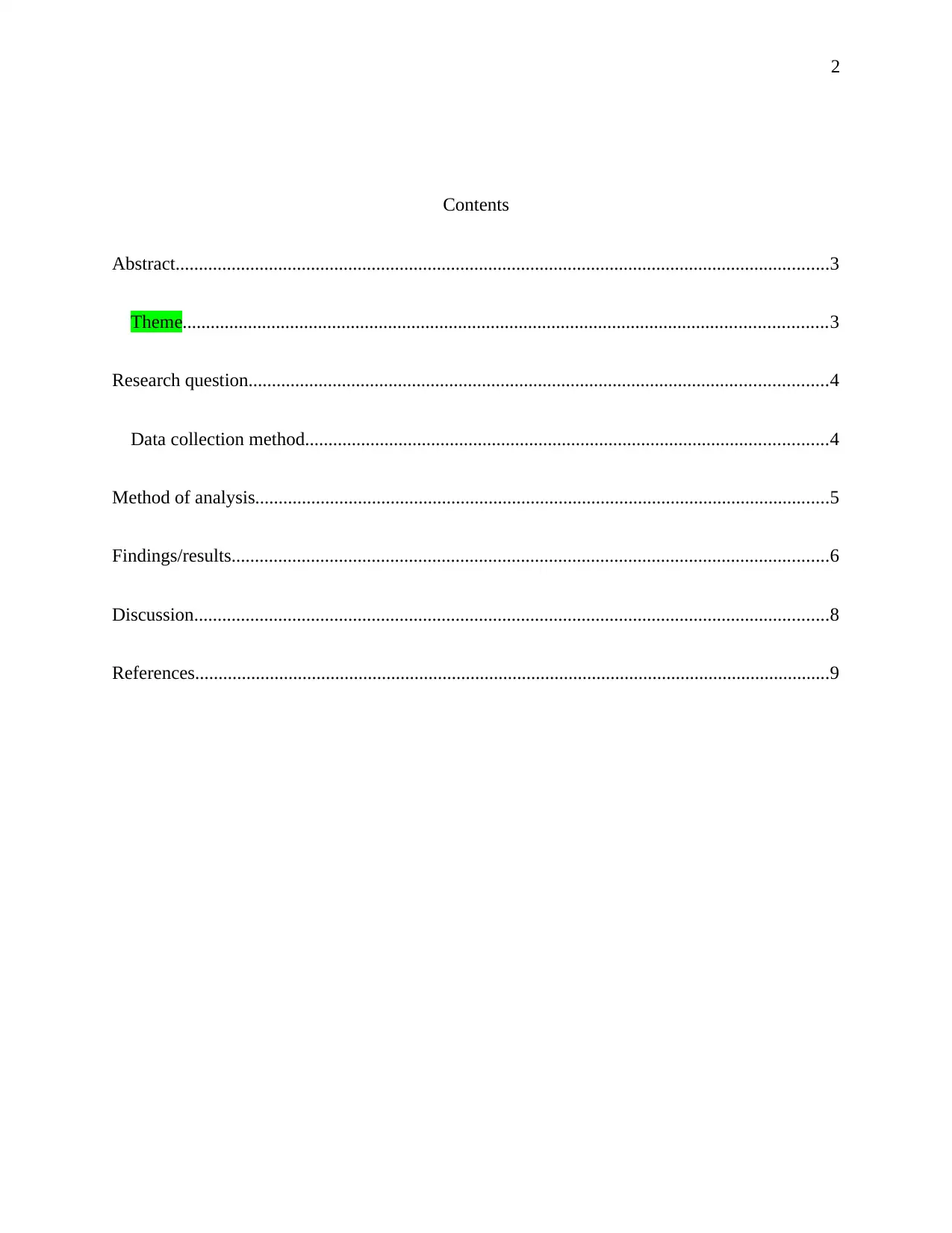
2
Contents
Abstract............................................................................................................................................3
Theme..........................................................................................................................................3
Research question............................................................................................................................4
Data collection method................................................................................................................4
Method of analysis...........................................................................................................................5
Findings/results................................................................................................................................6
Discussion........................................................................................................................................8
References........................................................................................................................................9
Contents
Abstract............................................................................................................................................3
Theme..........................................................................................................................................3
Research question............................................................................................................................4
Data collection method................................................................................................................4
Method of analysis...........................................................................................................................5
Findings/results................................................................................................................................6
Discussion........................................................................................................................................8
References........................................................................................................................................9
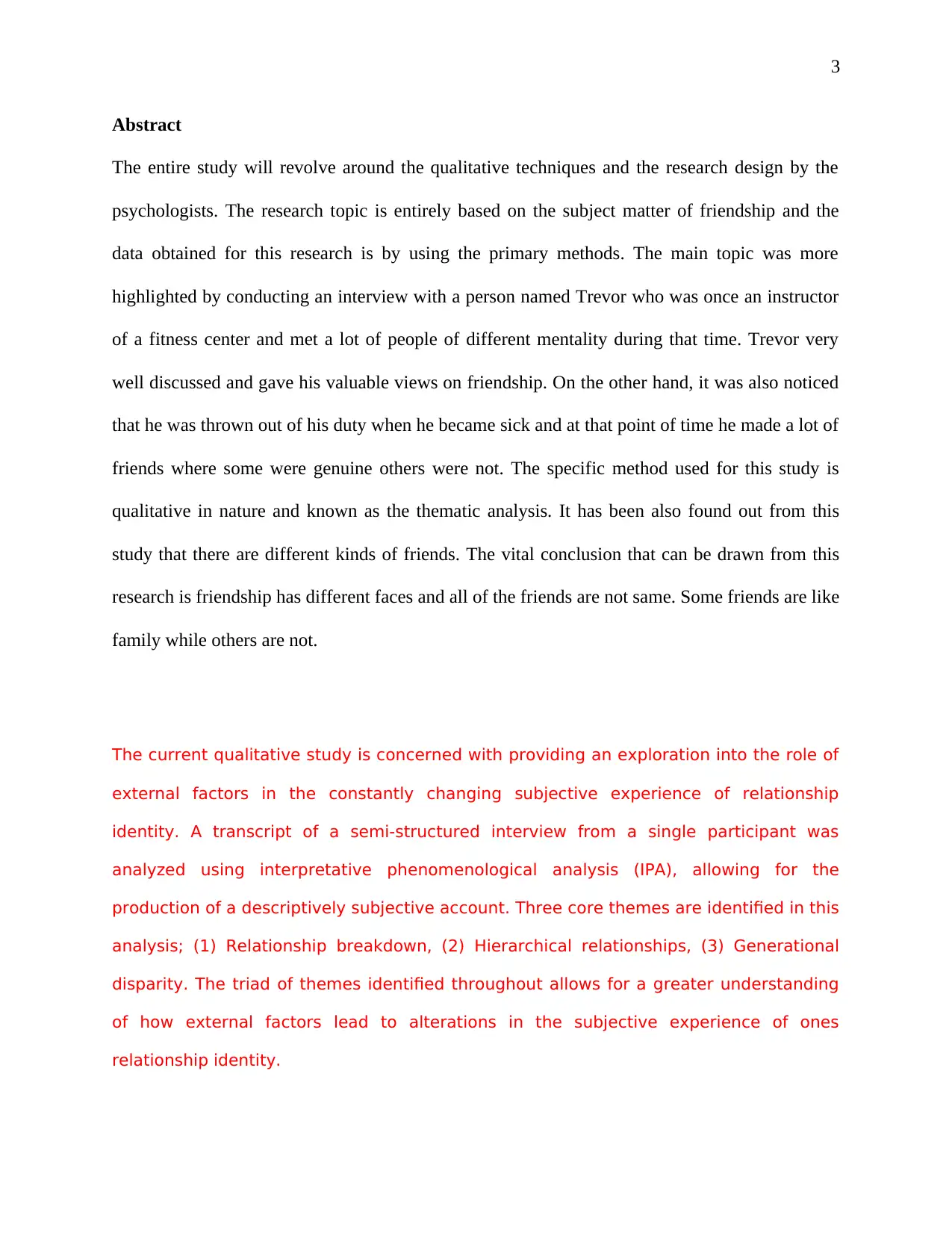
3
Abstract
The entire study will revolve around the qualitative techniques and the research design by the
psychologists. The research topic is entirely based on the subject matter of friendship and the
data obtained for this research is by using the primary methods. The main topic was more
highlighted by conducting an interview with a person named Trevor who was once an instructor
of a fitness center and met a lot of people of different mentality during that time. Trevor very
well discussed and gave his valuable views on friendship. On the other hand, it was also noticed
that he was thrown out of his duty when he became sick and at that point of time he made a lot of
friends where some were genuine others were not. The specific method used for this study is
qualitative in nature and known as the thematic analysis. It has been also found out from this
study that there are different kinds of friends. The vital conclusion that can be drawn from this
research is friendship has different faces and all of the friends are not same. Some friends are like
family while others are not.
The current qualitative study is concerned with providing an exploration into the role of
external factors in the constantly changing subjective experience of relationship
identity. A transcript of a semi-structured interview from a single participant was
analyzed using interpretative phenomenological analysis (IPA), allowing for the
production of a descriptively subjective account. Three core themes are identified in this
analysis; (1) Relationship breakdown, (2) Hierarchical relationships, (3) Generational
disparity. The triad of themes identified throughout allows for a greater understanding
of how external factors lead to alterations in the subjective experience of ones
relationship identity.
Abstract
The entire study will revolve around the qualitative techniques and the research design by the
psychologists. The research topic is entirely based on the subject matter of friendship and the
data obtained for this research is by using the primary methods. The main topic was more
highlighted by conducting an interview with a person named Trevor who was once an instructor
of a fitness center and met a lot of people of different mentality during that time. Trevor very
well discussed and gave his valuable views on friendship. On the other hand, it was also noticed
that he was thrown out of his duty when he became sick and at that point of time he made a lot of
friends where some were genuine others were not. The specific method used for this study is
qualitative in nature and known as the thematic analysis. It has been also found out from this
study that there are different kinds of friends. The vital conclusion that can be drawn from this
research is friendship has different faces and all of the friends are not same. Some friends are like
family while others are not.
The current qualitative study is concerned with providing an exploration into the role of
external factors in the constantly changing subjective experience of relationship
identity. A transcript of a semi-structured interview from a single participant was
analyzed using interpretative phenomenological analysis (IPA), allowing for the
production of a descriptively subjective account. Three core themes are identified in this
analysis; (1) Relationship breakdown, (2) Hierarchical relationships, (3) Generational
disparity. The triad of themes identified throughout allows for a greater understanding
of how external factors lead to alterations in the subjective experience of ones
relationship identity.
⊘ This is a preview!⊘
Do you want full access?
Subscribe today to unlock all pages.

Trusted by 1+ million students worldwide
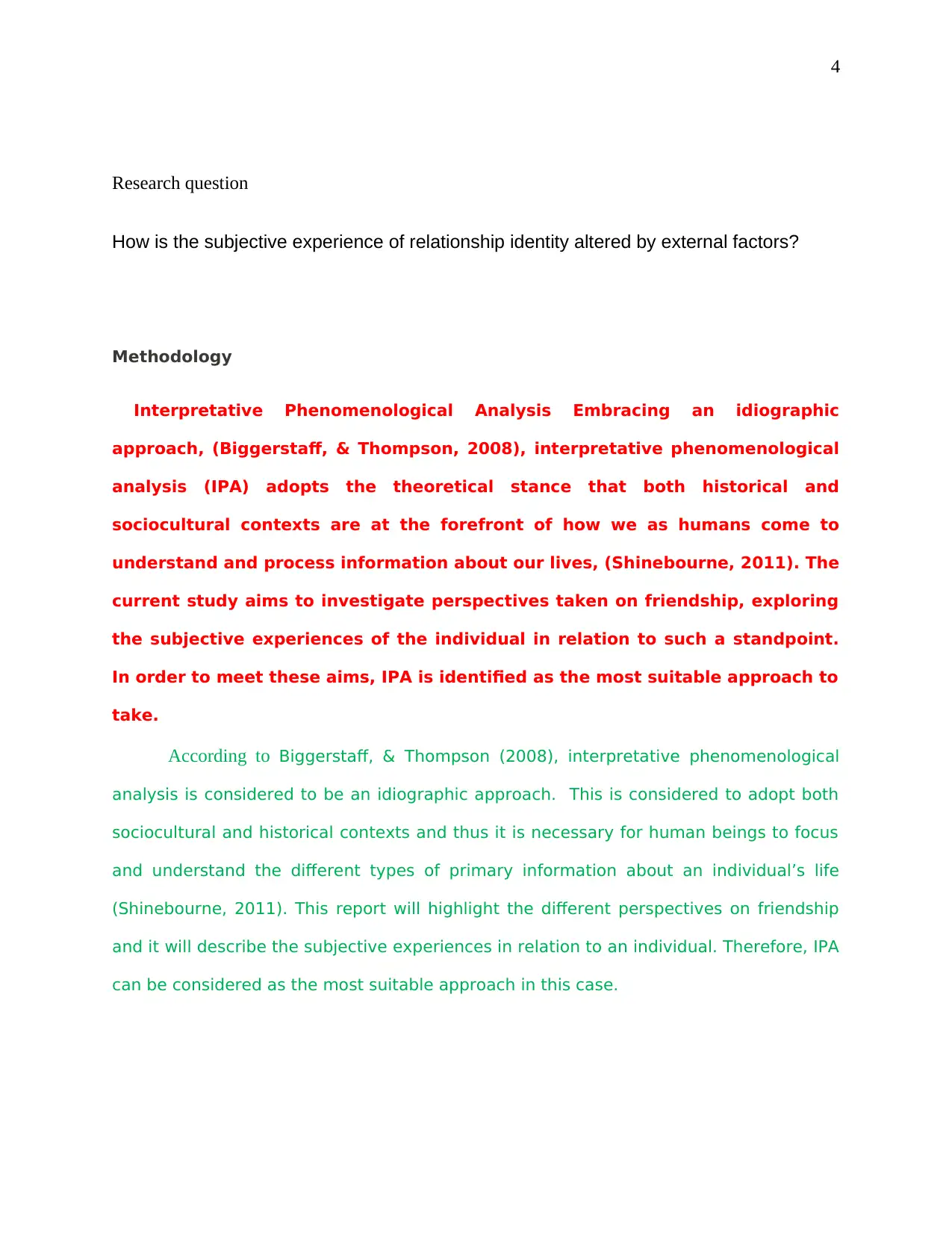
4
Research question
How is the subjective experience of relationship identity altered by external factors?
Methodology
Interpretative Phenomenological Analysis Embracing an idiographic
approach, (Biggerstaff, & Thompson, 2008), interpretative phenomenological
analysis (IPA) adopts the theoretical stance that both historical and
sociocultural contexts are at the forefront of how we as humans come to
understand and process information about our lives, (Shinebourne, 2011). The
current study aims to investigate perspectives taken on friendship, exploring
the subjective experiences of the individual in relation to such a standpoint.
In order to meet these aims, IPA is identified as the most suitable approach to
take.
According to Biggerstaff, & Thompson (2008), interpretative phenomenological
analysis is considered to be an idiographic approach. This is considered to adopt both
sociocultural and historical contexts and thus it is necessary for human beings to focus
and understand the different types of primary information about an individual’s life
(Shinebourne, 2011). This report will highlight the different perspectives on friendship
and it will describe the subjective experiences in relation to an individual. Therefore, IPA
can be considered as the most suitable approach in this case.
Research question
How is the subjective experience of relationship identity altered by external factors?
Methodology
Interpretative Phenomenological Analysis Embracing an idiographic
approach, (Biggerstaff, & Thompson, 2008), interpretative phenomenological
analysis (IPA) adopts the theoretical stance that both historical and
sociocultural contexts are at the forefront of how we as humans come to
understand and process information about our lives, (Shinebourne, 2011). The
current study aims to investigate perspectives taken on friendship, exploring
the subjective experiences of the individual in relation to such a standpoint.
In order to meet these aims, IPA is identified as the most suitable approach to
take.
According to Biggerstaff, & Thompson (2008), interpretative phenomenological
analysis is considered to be an idiographic approach. This is considered to adopt both
sociocultural and historical contexts and thus it is necessary for human beings to focus
and understand the different types of primary information about an individual’s life
(Shinebourne, 2011). This report will highlight the different perspectives on friendship
and it will describe the subjective experiences in relation to an individual. Therefore, IPA
can be considered as the most suitable approach in this case.
Paraphrase This Document
Need a fresh take? Get an instant paraphrase of this document with our AI Paraphraser
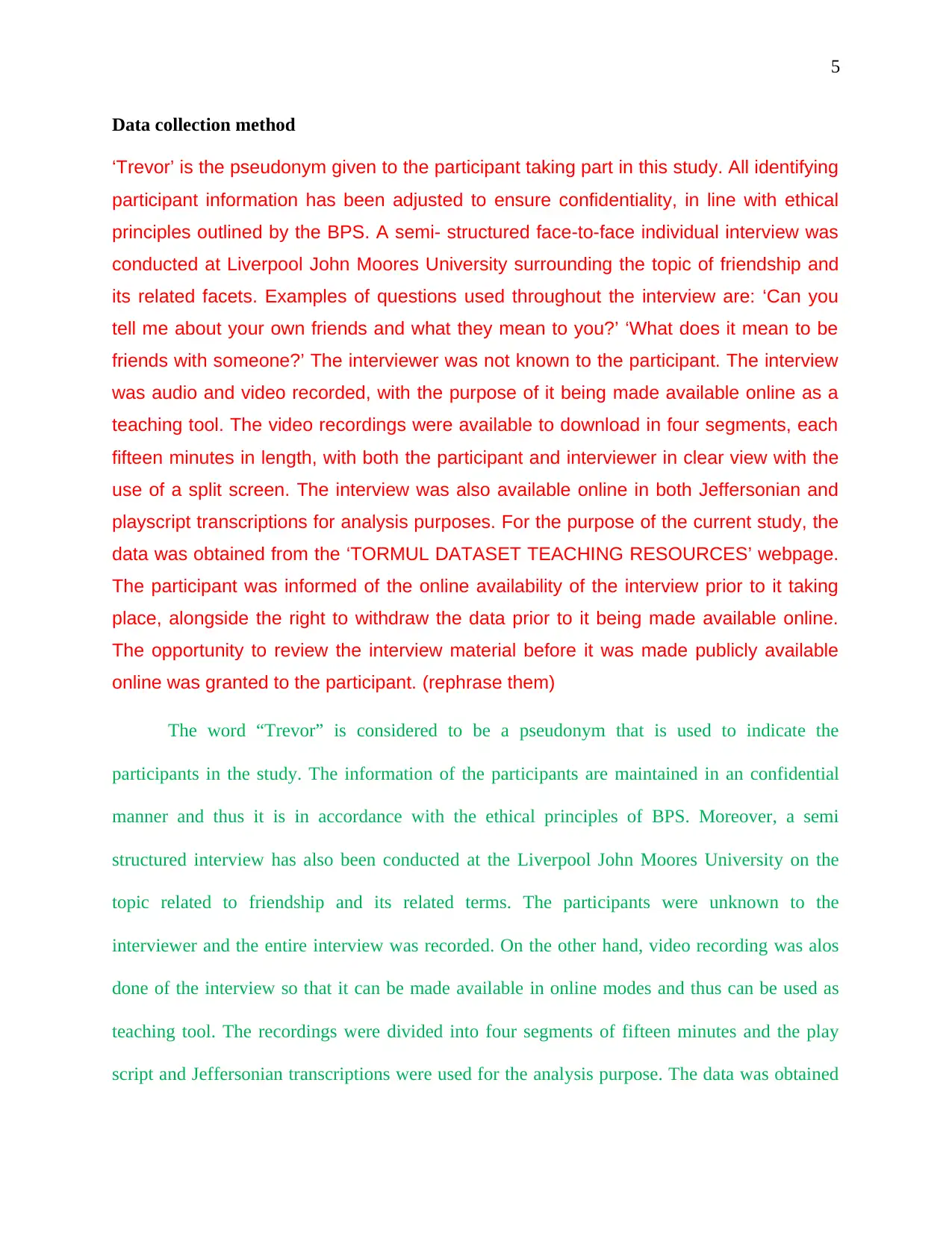
5
Data collection method
‘Trevor’ is the pseudonym given to the participant taking part in this study. All identifying
participant information has been adjusted to ensure confidentiality, in line with ethical
principles outlined by the BPS. A semi- structured face-to-face individual interview was
conducted at Liverpool John Moores University surrounding the topic of friendship and
its related facets. Examples of questions used throughout the interview are: ‘Can you
tell me about your own friends and what they mean to you?’ ‘What does it mean to be
friends with someone?’ The interviewer was not known to the participant. The interview
was audio and video recorded, with the purpose of it being made available online as a
teaching tool. The video recordings were available to download in four segments, each
fifteen minutes in length, with both the participant and interviewer in clear view with the
use of a split screen. The interview was also available online in both Jeffersonian and
playscript transcriptions for analysis purposes. For the purpose of the current study, the
data was obtained from the ‘TORMUL DATASET TEACHING RESOURCES’ webpage.
The participant was informed of the online availability of the interview prior to it taking
place, alongside the right to withdraw the data prior to it being made available online.
The opportunity to review the interview material before it was made publicly available
online was granted to the participant. (rephrase them)
The word “Trevor” is considered to be a pseudonym that is used to indicate the
participants in the study. The information of the participants are maintained in an confidential
manner and thus it is in accordance with the ethical principles of BPS. Moreover, a semi
structured interview has also been conducted at the Liverpool John Moores University on the
topic related to friendship and its related terms. The participants were unknown to the
interviewer and the entire interview was recorded. On the other hand, video recording was alos
done of the interview so that it can be made available in online modes and thus can be used as
teaching tool. The recordings were divided into four segments of fifteen minutes and the play
script and Jeffersonian transcriptions were used for the analysis purpose. The data was obtained
Data collection method
‘Trevor’ is the pseudonym given to the participant taking part in this study. All identifying
participant information has been adjusted to ensure confidentiality, in line with ethical
principles outlined by the BPS. A semi- structured face-to-face individual interview was
conducted at Liverpool John Moores University surrounding the topic of friendship and
its related facets. Examples of questions used throughout the interview are: ‘Can you
tell me about your own friends and what they mean to you?’ ‘What does it mean to be
friends with someone?’ The interviewer was not known to the participant. The interview
was audio and video recorded, with the purpose of it being made available online as a
teaching tool. The video recordings were available to download in four segments, each
fifteen minutes in length, with both the participant and interviewer in clear view with the
use of a split screen. The interview was also available online in both Jeffersonian and
playscript transcriptions for analysis purposes. For the purpose of the current study, the
data was obtained from the ‘TORMUL DATASET TEACHING RESOURCES’ webpage.
The participant was informed of the online availability of the interview prior to it taking
place, alongside the right to withdraw the data prior to it being made available online.
The opportunity to review the interview material before it was made publicly available
online was granted to the participant. (rephrase them)
The word “Trevor” is considered to be a pseudonym that is used to indicate the
participants in the study. The information of the participants are maintained in an confidential
manner and thus it is in accordance with the ethical principles of BPS. Moreover, a semi
structured interview has also been conducted at the Liverpool John Moores University on the
topic related to friendship and its related terms. The participants were unknown to the
interviewer and the entire interview was recorded. On the other hand, video recording was alos
done of the interview so that it can be made available in online modes and thus can be used as
teaching tool. The recordings were divided into four segments of fifteen minutes and the play
script and Jeffersonian transcriptions were used for the analysis purpose. The data was obtained
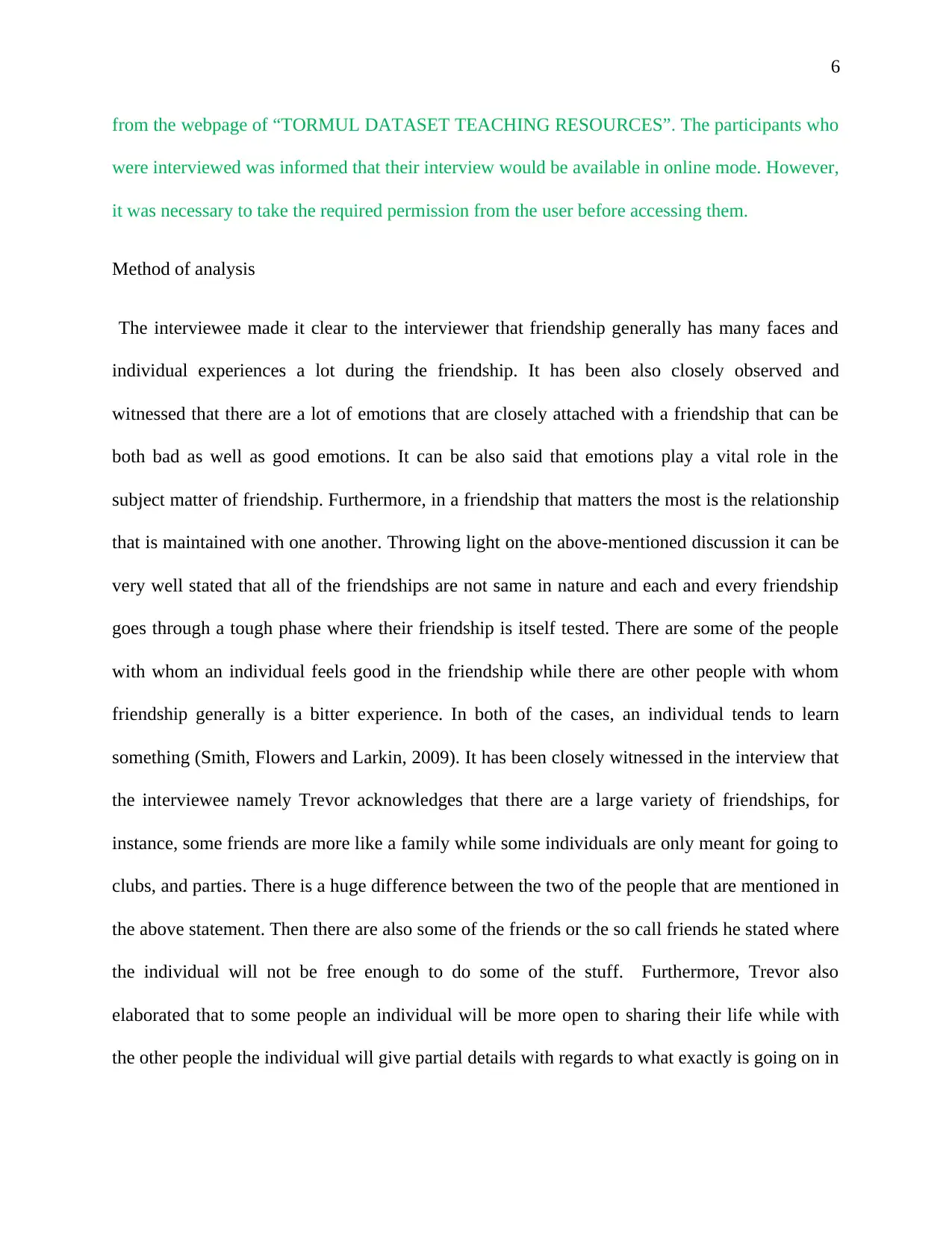
6
from the webpage of “TORMUL DATASET TEACHING RESOURCES”. The participants who
were interviewed was informed that their interview would be available in online mode. However,
it was necessary to take the required permission from the user before accessing them.
Method of analysis
The interviewee made it clear to the interviewer that friendship generally has many faces and
individual experiences a lot during the friendship. It has been also closely observed and
witnessed that there are a lot of emotions that are closely attached with a friendship that can be
both bad as well as good emotions. It can be also said that emotions play a vital role in the
subject matter of friendship. Furthermore, in a friendship that matters the most is the relationship
that is maintained with one another. Throwing light on the above-mentioned discussion it can be
very well stated that all of the friendships are not same in nature and each and every friendship
goes through a tough phase where their friendship is itself tested. There are some of the people
with whom an individual feels good in the friendship while there are other people with whom
friendship generally is a bitter experience. In both of the cases, an individual tends to learn
something (Smith, Flowers and Larkin, 2009). It has been closely witnessed in the interview that
the interviewee namely Trevor acknowledges that there are a large variety of friendships, for
instance, some friends are more like a family while some individuals are only meant for going to
clubs, and parties. There is a huge difference between the two of the people that are mentioned in
the above statement. Then there are also some of the friends or the so call friends he stated where
the individual will not be free enough to do some of the stuff. Furthermore, Trevor also
elaborated that to some people an individual will be more open to sharing their life while with
the other people the individual will give partial details with regards to what exactly is going on in
from the webpage of “TORMUL DATASET TEACHING RESOURCES”. The participants who
were interviewed was informed that their interview would be available in online mode. However,
it was necessary to take the required permission from the user before accessing them.
Method of analysis
The interviewee made it clear to the interviewer that friendship generally has many faces and
individual experiences a lot during the friendship. It has been also closely observed and
witnessed that there are a lot of emotions that are closely attached with a friendship that can be
both bad as well as good emotions. It can be also said that emotions play a vital role in the
subject matter of friendship. Furthermore, in a friendship that matters the most is the relationship
that is maintained with one another. Throwing light on the above-mentioned discussion it can be
very well stated that all of the friendships are not same in nature and each and every friendship
goes through a tough phase where their friendship is itself tested. There are some of the people
with whom an individual feels good in the friendship while there are other people with whom
friendship generally is a bitter experience. In both of the cases, an individual tends to learn
something (Smith, Flowers and Larkin, 2009). It has been closely witnessed in the interview that
the interviewee namely Trevor acknowledges that there are a large variety of friendships, for
instance, some friends are more like a family while some individuals are only meant for going to
clubs, and parties. There is a huge difference between the two of the people that are mentioned in
the above statement. Then there are also some of the friends or the so call friends he stated where
the individual will not be free enough to do some of the stuff. Furthermore, Trevor also
elaborated that to some people an individual will be more open to sharing their life while with
the other people the individual will give partial details with regards to what exactly is going on in
⊘ This is a preview!⊘
Do you want full access?
Subscribe today to unlock all pages.

Trusted by 1+ million students worldwide
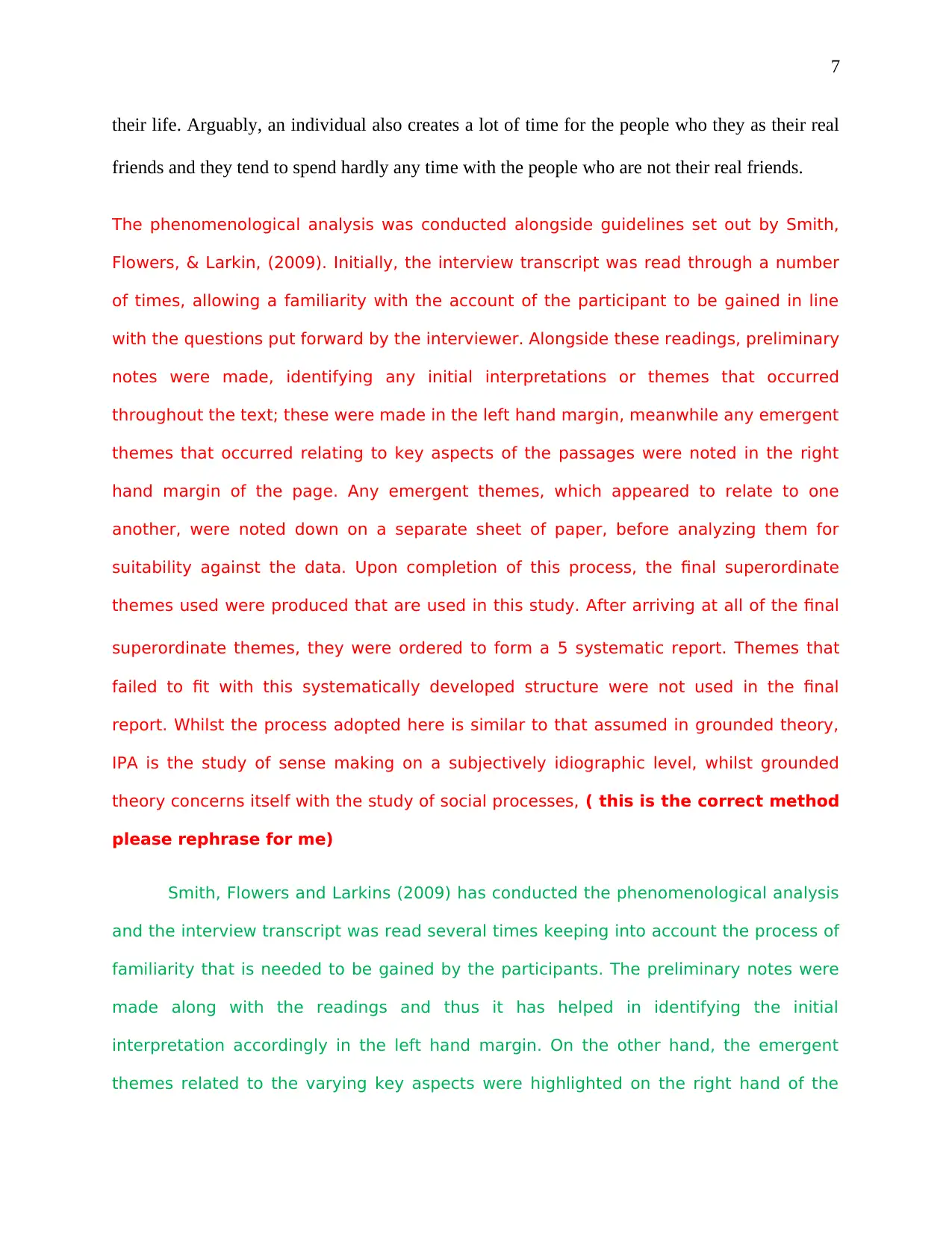
7
their life. Arguably, an individual also creates a lot of time for the people who they as their real
friends and they tend to spend hardly any time with the people who are not their real friends.
The phenomenological analysis was conducted alongside guidelines set out by Smith,
Flowers, & Larkin, (2009). Initially, the interview transcript was read through a number
of times, allowing a familiarity with the account of the participant to be gained in line
with the questions put forward by the interviewer. Alongside these readings, preliminary
notes were made, identifying any initial interpretations or themes that occurred
throughout the text; these were made in the left hand margin, meanwhile any emergent
themes that occurred relating to key aspects of the passages were noted in the right
hand margin of the page. Any emergent themes, which appeared to relate to one
another, were noted down on a separate sheet of paper, before analyzing them for
suitability against the data. Upon completion of this process, the final superordinate
themes used were produced that are used in this study. After arriving at all of the final
superordinate themes, they were ordered to form a 5 systematic report. Themes that
failed to fit with this systematically developed structure were not used in the final
report. Whilst the process adopted here is similar to that assumed in grounded theory,
IPA is the study of sense making on a subjectively idiographic level, whilst grounded
theory concerns itself with the study of social processes, ( this is the correct method
please rephrase for me)
Smith, Flowers and Larkins (2009) has conducted the phenomenological analysis
and the interview transcript was read several times keeping into account the process of
familiarity that is needed to be gained by the participants. The preliminary notes were
made along with the readings and thus it has helped in identifying the initial
interpretation accordingly in the left hand margin. On the other hand, the emergent
themes related to the varying key aspects were highlighted on the right hand of the
their life. Arguably, an individual also creates a lot of time for the people who they as their real
friends and they tend to spend hardly any time with the people who are not their real friends.
The phenomenological analysis was conducted alongside guidelines set out by Smith,
Flowers, & Larkin, (2009). Initially, the interview transcript was read through a number
of times, allowing a familiarity with the account of the participant to be gained in line
with the questions put forward by the interviewer. Alongside these readings, preliminary
notes were made, identifying any initial interpretations or themes that occurred
throughout the text; these were made in the left hand margin, meanwhile any emergent
themes that occurred relating to key aspects of the passages were noted in the right
hand margin of the page. Any emergent themes, which appeared to relate to one
another, were noted down on a separate sheet of paper, before analyzing them for
suitability against the data. Upon completion of this process, the final superordinate
themes used were produced that are used in this study. After arriving at all of the final
superordinate themes, they were ordered to form a 5 systematic report. Themes that
failed to fit with this systematically developed structure were not used in the final
report. Whilst the process adopted here is similar to that assumed in grounded theory,
IPA is the study of sense making on a subjectively idiographic level, whilst grounded
theory concerns itself with the study of social processes, ( this is the correct method
please rephrase for me)
Smith, Flowers and Larkins (2009) has conducted the phenomenological analysis
and the interview transcript was read several times keeping into account the process of
familiarity that is needed to be gained by the participants. The preliminary notes were
made along with the readings and thus it has helped in identifying the initial
interpretation accordingly in the left hand margin. On the other hand, the emergent
themes related to the varying key aspects were highlighted on the right hand of the
Paraphrase This Document
Need a fresh take? Get an instant paraphrase of this document with our AI Paraphraser
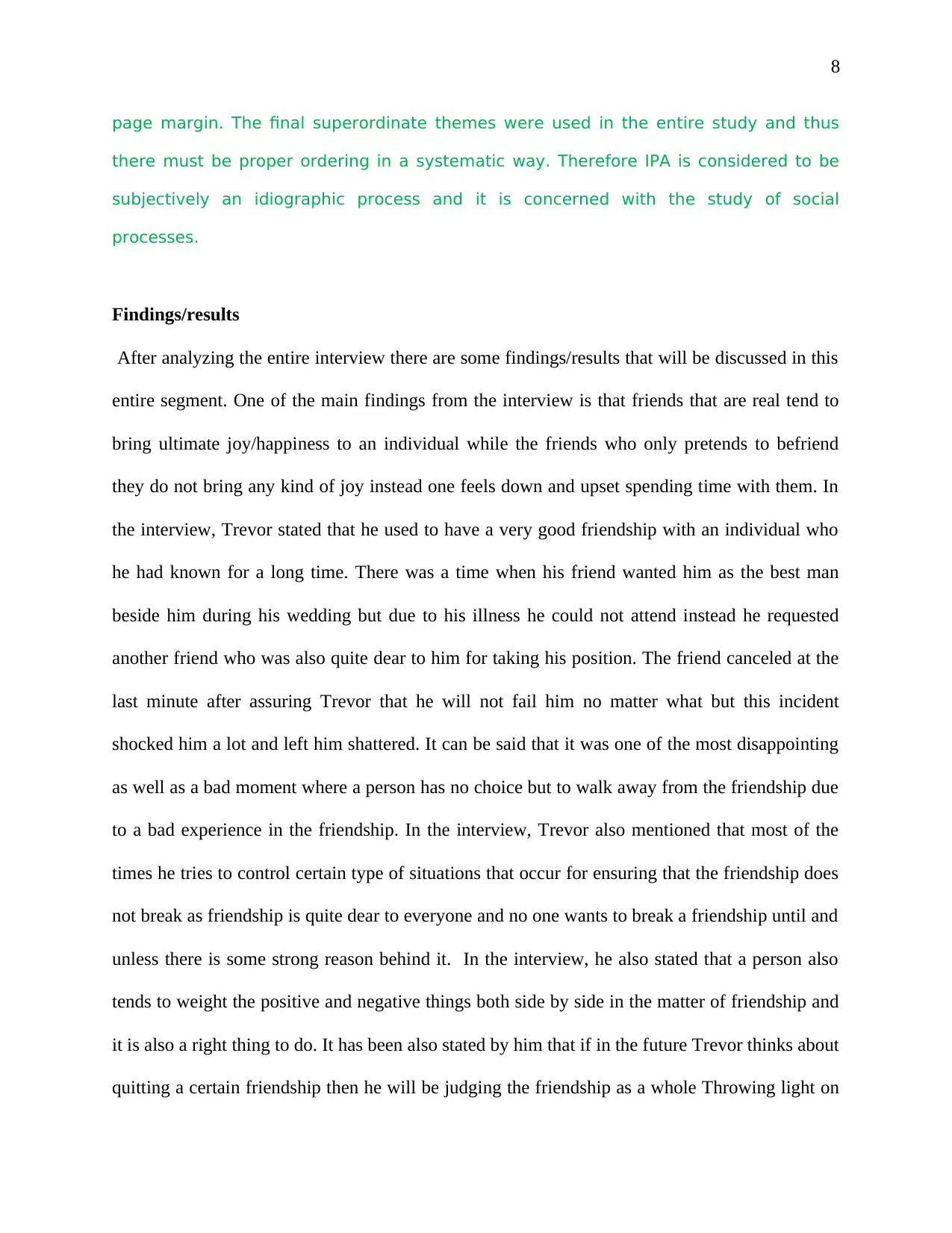
8
page margin. The final superordinate themes were used in the entire study and thus
there must be proper ordering in a systematic way. Therefore IPA is considered to be
subjectively an idiographic process and it is concerned with the study of social
processes.
Findings/results
After analyzing the entire interview there are some findings/results that will be discussed in this
entire segment. One of the main findings from the interview is that friends that are real tend to
bring ultimate joy/happiness to an individual while the friends who only pretends to befriend
they do not bring any kind of joy instead one feels down and upset spending time with them. In
the interview, Trevor stated that he used to have a very good friendship with an individual who
he had known for a long time. There was a time when his friend wanted him as the best man
beside him during his wedding but due to his illness he could not attend instead he requested
another friend who was also quite dear to him for taking his position. The friend canceled at the
last minute after assuring Trevor that he will not fail him no matter what but this incident
shocked him a lot and left him shattered. It can be said that it was one of the most disappointing
as well as a bad moment where a person has no choice but to walk away from the friendship due
to a bad experience in the friendship. In the interview, Trevor also mentioned that most of the
times he tries to control certain type of situations that occur for ensuring that the friendship does
not break as friendship is quite dear to everyone and no one wants to break a friendship until and
unless there is some strong reason behind it. In the interview, he also stated that a person also
tends to weight the positive and negative things both side by side in the matter of friendship and
it is also a right thing to do. It has been also stated by him that if in the future Trevor thinks about
quitting a certain friendship then he will be judging the friendship as a whole Throwing light on
page margin. The final superordinate themes were used in the entire study and thus
there must be proper ordering in a systematic way. Therefore IPA is considered to be
subjectively an idiographic process and it is concerned with the study of social
processes.
Findings/results
After analyzing the entire interview there are some findings/results that will be discussed in this
entire segment. One of the main findings from the interview is that friends that are real tend to
bring ultimate joy/happiness to an individual while the friends who only pretends to befriend
they do not bring any kind of joy instead one feels down and upset spending time with them. In
the interview, Trevor stated that he used to have a very good friendship with an individual who
he had known for a long time. There was a time when his friend wanted him as the best man
beside him during his wedding but due to his illness he could not attend instead he requested
another friend who was also quite dear to him for taking his position. The friend canceled at the
last minute after assuring Trevor that he will not fail him no matter what but this incident
shocked him a lot and left him shattered. It can be said that it was one of the most disappointing
as well as a bad moment where a person has no choice but to walk away from the friendship due
to a bad experience in the friendship. In the interview, Trevor also mentioned that most of the
times he tries to control certain type of situations that occur for ensuring that the friendship does
not break as friendship is quite dear to everyone and no one wants to break a friendship until and
unless there is some strong reason behind it. In the interview, he also stated that a person also
tends to weight the positive and negative things both side by side in the matter of friendship and
it is also a right thing to do. It has been also stated by him that if in the future Trevor thinks about
quitting a certain friendship then he will be judging the friendship as a whole Throwing light on
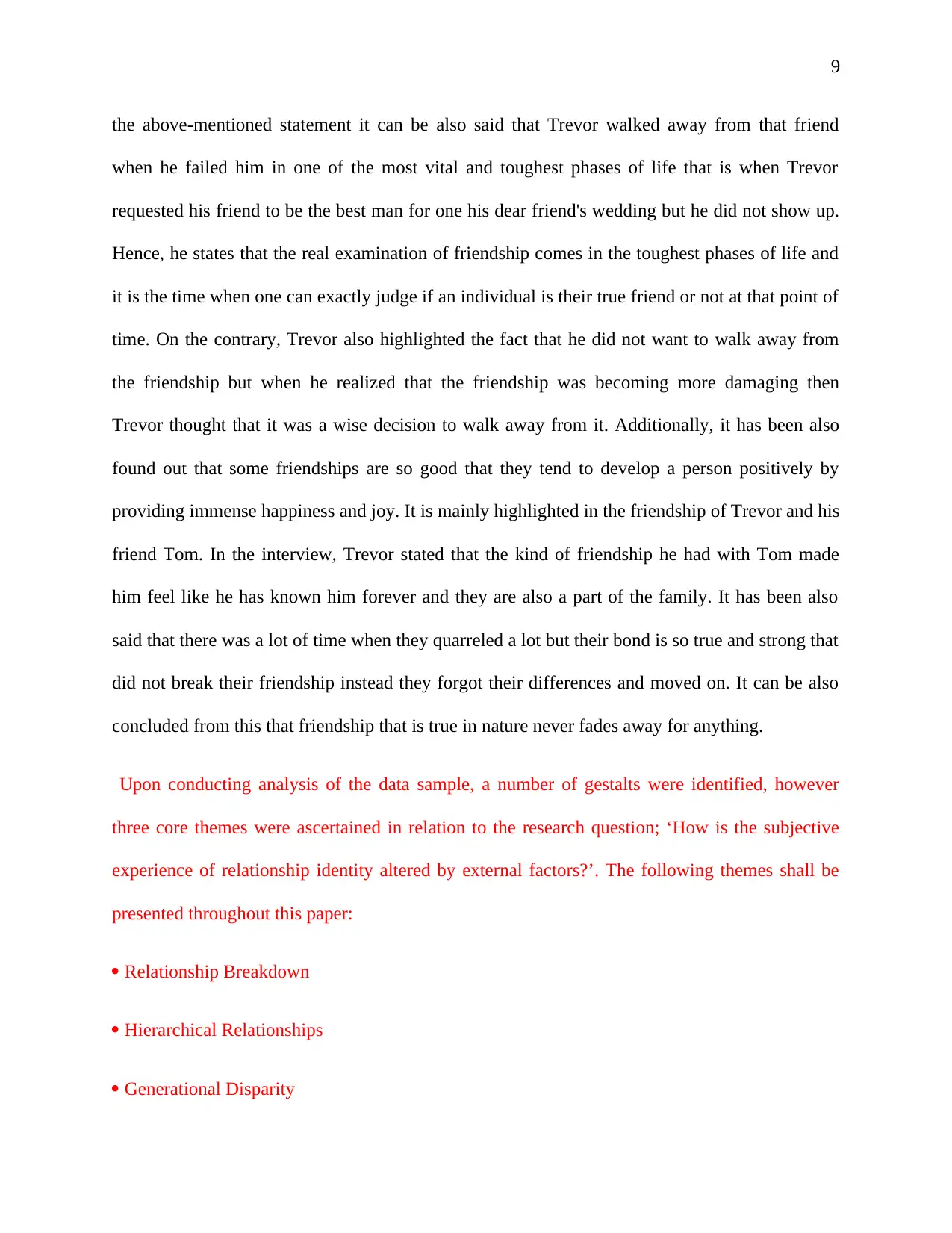
9
the above-mentioned statement it can be also said that Trevor walked away from that friend
when he failed him in one of the most vital and toughest phases of life that is when Trevor
requested his friend to be the best man for one his dear friend's wedding but he did not show up.
Hence, he states that the real examination of friendship comes in the toughest phases of life and
it is the time when one can exactly judge if an individual is their true friend or not at that point of
time. On the contrary, Trevor also highlighted the fact that he did not want to walk away from
the friendship but when he realized that the friendship was becoming more damaging then
Trevor thought that it was a wise decision to walk away from it. Additionally, it has been also
found out that some friendships are so good that they tend to develop a person positively by
providing immense happiness and joy. It is mainly highlighted in the friendship of Trevor and his
friend Tom. In the interview, Trevor stated that the kind of friendship he had with Tom made
him feel like he has known him forever and they are also a part of the family. It has been also
said that there was a lot of time when they quarreled a lot but their bond is so true and strong that
did not break their friendship instead they forgot their differences and moved on. It can be also
concluded from this that friendship that is true in nature never fades away for anything.
Upon conducting analysis of the data sample, a number of gestalts were identified, however
three core themes were ascertained in relation to the research question; ‘How is the subjective
experience of relationship identity altered by external factors?’. The following themes shall be
presented throughout this paper:
Relationship Breakdown
Hierarchical Relationships
Generational Disparity
the above-mentioned statement it can be also said that Trevor walked away from that friend
when he failed him in one of the most vital and toughest phases of life that is when Trevor
requested his friend to be the best man for one his dear friend's wedding but he did not show up.
Hence, he states that the real examination of friendship comes in the toughest phases of life and
it is the time when one can exactly judge if an individual is their true friend or not at that point of
time. On the contrary, Trevor also highlighted the fact that he did not want to walk away from
the friendship but when he realized that the friendship was becoming more damaging then
Trevor thought that it was a wise decision to walk away from it. Additionally, it has been also
found out that some friendships are so good that they tend to develop a person positively by
providing immense happiness and joy. It is mainly highlighted in the friendship of Trevor and his
friend Tom. In the interview, Trevor stated that the kind of friendship he had with Tom made
him feel like he has known him forever and they are also a part of the family. It has been also
said that there was a lot of time when they quarreled a lot but their bond is so true and strong that
did not break their friendship instead they forgot their differences and moved on. It can be also
concluded from this that friendship that is true in nature never fades away for anything.
Upon conducting analysis of the data sample, a number of gestalts were identified, however
three core themes were ascertained in relation to the research question; ‘How is the subjective
experience of relationship identity altered by external factors?’. The following themes shall be
presented throughout this paper:
Relationship Breakdown
Hierarchical Relationships
Generational Disparity
⊘ This is a preview!⊘
Do you want full access?
Subscribe today to unlock all pages.

Trusted by 1+ million students worldwide
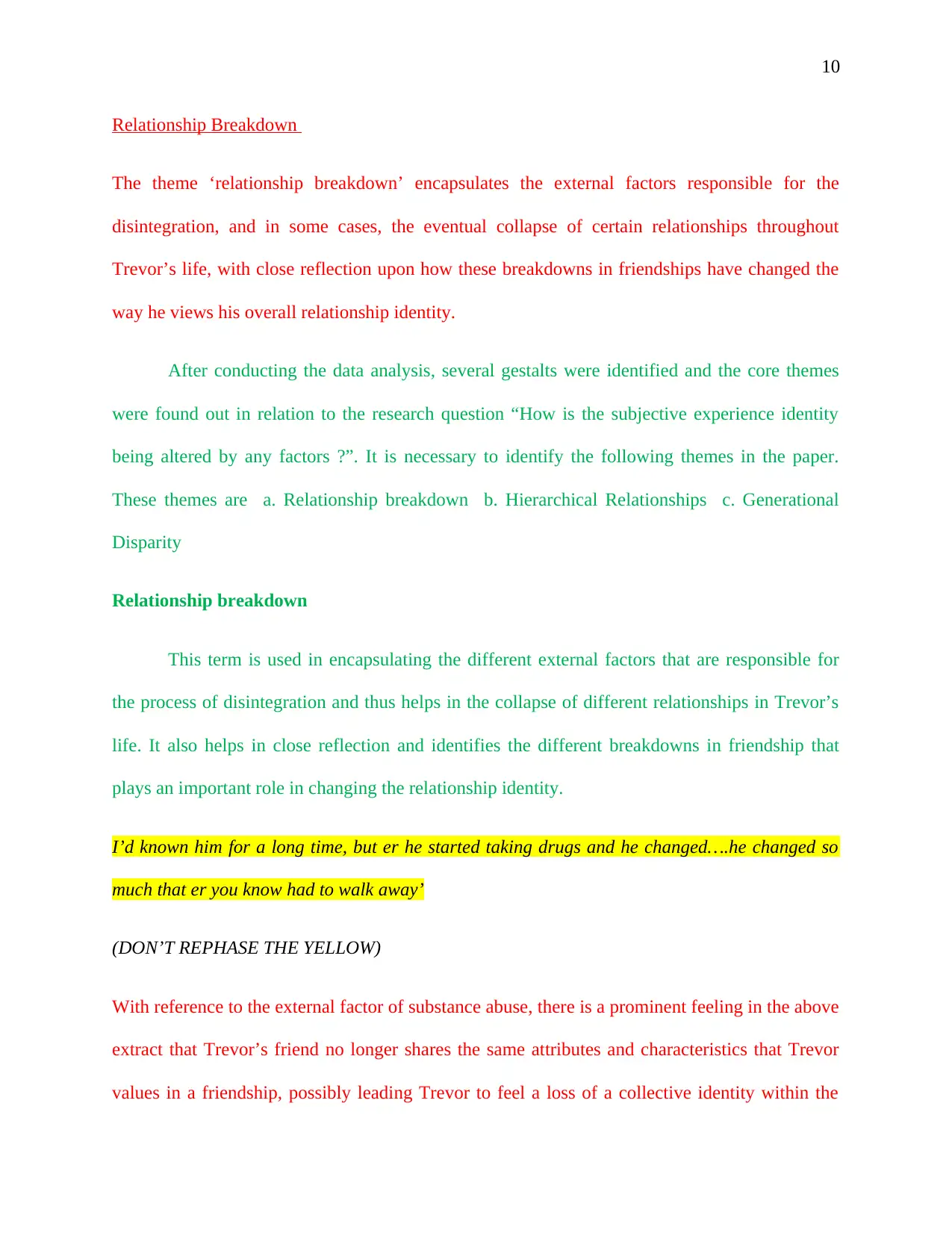
10
Relationship Breakdown
The theme ‘relationship breakdown’ encapsulates the external factors responsible for the
disintegration, and in some cases, the eventual collapse of certain relationships throughout
Trevor’s life, with close reflection upon how these breakdowns in friendships have changed the
way he views his overall relationship identity.
After conducting the data analysis, several gestalts were identified and the core themes
were found out in relation to the research question “How is the subjective experience identity
being altered by any factors ?”. It is necessary to identify the following themes in the paper.
These themes are a. Relationship breakdown b. Hierarchical Relationships c. Generational
Disparity
Relationship breakdown
This term is used in encapsulating the different external factors that are responsible for
the process of disintegration and thus helps in the collapse of different relationships in Trevor’s
life. It also helps in close reflection and identifies the different breakdowns in friendship that
plays an important role in changing the relationship identity.
I’d known him for a long time, but er he started taking drugs and he changed….he changed so
much that er you know had to walk away’
(DON’T REPHASE THE YELLOW)
With reference to the external factor of substance abuse, there is a prominent feeling in the above
extract that Trevor’s friend no longer shares the same attributes and characteristics that Trevor
values in a friendship, possibly leading Trevor to feel a loss of a collective identity within the
Relationship Breakdown
The theme ‘relationship breakdown’ encapsulates the external factors responsible for the
disintegration, and in some cases, the eventual collapse of certain relationships throughout
Trevor’s life, with close reflection upon how these breakdowns in friendships have changed the
way he views his overall relationship identity.
After conducting the data analysis, several gestalts were identified and the core themes
were found out in relation to the research question “How is the subjective experience identity
being altered by any factors ?”. It is necessary to identify the following themes in the paper.
These themes are a. Relationship breakdown b. Hierarchical Relationships c. Generational
Disparity
Relationship breakdown
This term is used in encapsulating the different external factors that are responsible for
the process of disintegration and thus helps in the collapse of different relationships in Trevor’s
life. It also helps in close reflection and identifies the different breakdowns in friendship that
plays an important role in changing the relationship identity.
I’d known him for a long time, but er he started taking drugs and he changed….he changed so
much that er you know had to walk away’
(DON’T REPHASE THE YELLOW)
With reference to the external factor of substance abuse, there is a prominent feeling in the above
extract that Trevor’s friend no longer shares the same attributes and characteristics that Trevor
values in a friendship, possibly leading Trevor to feel a loss of a collective identity within the
Paraphrase This Document
Need a fresh take? Get an instant paraphrase of this document with our AI Paraphraser
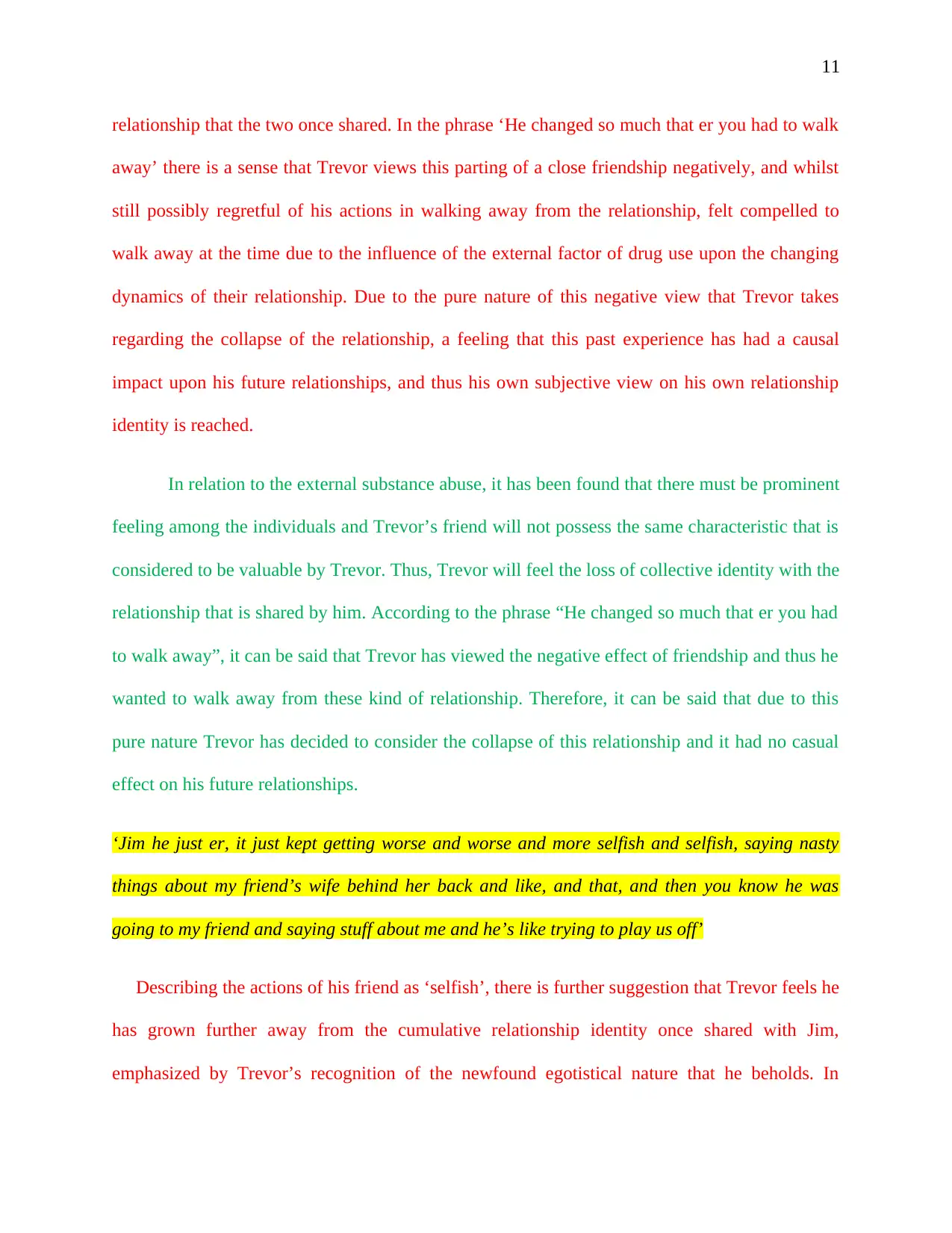
11
relationship that the two once shared. In the phrase ‘He changed so much that er you had to walk
away’ there is a sense that Trevor views this parting of a close friendship negatively, and whilst
still possibly regretful of his actions in walking away from the relationship, felt compelled to
walk away at the time due to the influence of the external factor of drug use upon the changing
dynamics of their relationship. Due to the pure nature of this negative view that Trevor takes
regarding the collapse of the relationship, a feeling that this past experience has had a causal
impact upon his future relationships, and thus his own subjective view on his own relationship
identity is reached.
In relation to the external substance abuse, it has been found that there must be prominent
feeling among the individuals and Trevor’s friend will not possess the same characteristic that is
considered to be valuable by Trevor. Thus, Trevor will feel the loss of collective identity with the
relationship that is shared by him. According to the phrase “He changed so much that er you had
to walk away”, it can be said that Trevor has viewed the negative effect of friendship and thus he
wanted to walk away from these kind of relationship. Therefore, it can be said that due to this
pure nature Trevor has decided to consider the collapse of this relationship and it had no casual
effect on his future relationships.
‘Jim he just er, it just kept getting worse and worse and more selfish and selfish, saying nasty
things about my friend’s wife behind her back and like, and that, and then you know he was
going to my friend and saying stuff about me and he’s like trying to play us off’
Describing the actions of his friend as ‘selfish’, there is further suggestion that Trevor feels he
has grown further away from the cumulative relationship identity once shared with Jim,
emphasized by Trevor’s recognition of the newfound egotistical nature that he beholds. In
relationship that the two once shared. In the phrase ‘He changed so much that er you had to walk
away’ there is a sense that Trevor views this parting of a close friendship negatively, and whilst
still possibly regretful of his actions in walking away from the relationship, felt compelled to
walk away at the time due to the influence of the external factor of drug use upon the changing
dynamics of their relationship. Due to the pure nature of this negative view that Trevor takes
regarding the collapse of the relationship, a feeling that this past experience has had a causal
impact upon his future relationships, and thus his own subjective view on his own relationship
identity is reached.
In relation to the external substance abuse, it has been found that there must be prominent
feeling among the individuals and Trevor’s friend will not possess the same characteristic that is
considered to be valuable by Trevor. Thus, Trevor will feel the loss of collective identity with the
relationship that is shared by him. According to the phrase “He changed so much that er you had
to walk away”, it can be said that Trevor has viewed the negative effect of friendship and thus he
wanted to walk away from these kind of relationship. Therefore, it can be said that due to this
pure nature Trevor has decided to consider the collapse of this relationship and it had no casual
effect on his future relationships.
‘Jim he just er, it just kept getting worse and worse and more selfish and selfish, saying nasty
things about my friend’s wife behind her back and like, and that, and then you know he was
going to my friend and saying stuff about me and he’s like trying to play us off’
Describing the actions of his friend as ‘selfish’, there is further suggestion that Trevor feels he
has grown further away from the cumulative relationship identity once shared with Jim,
emphasized by Trevor’s recognition of the newfound egotistical nature that he beholds. In
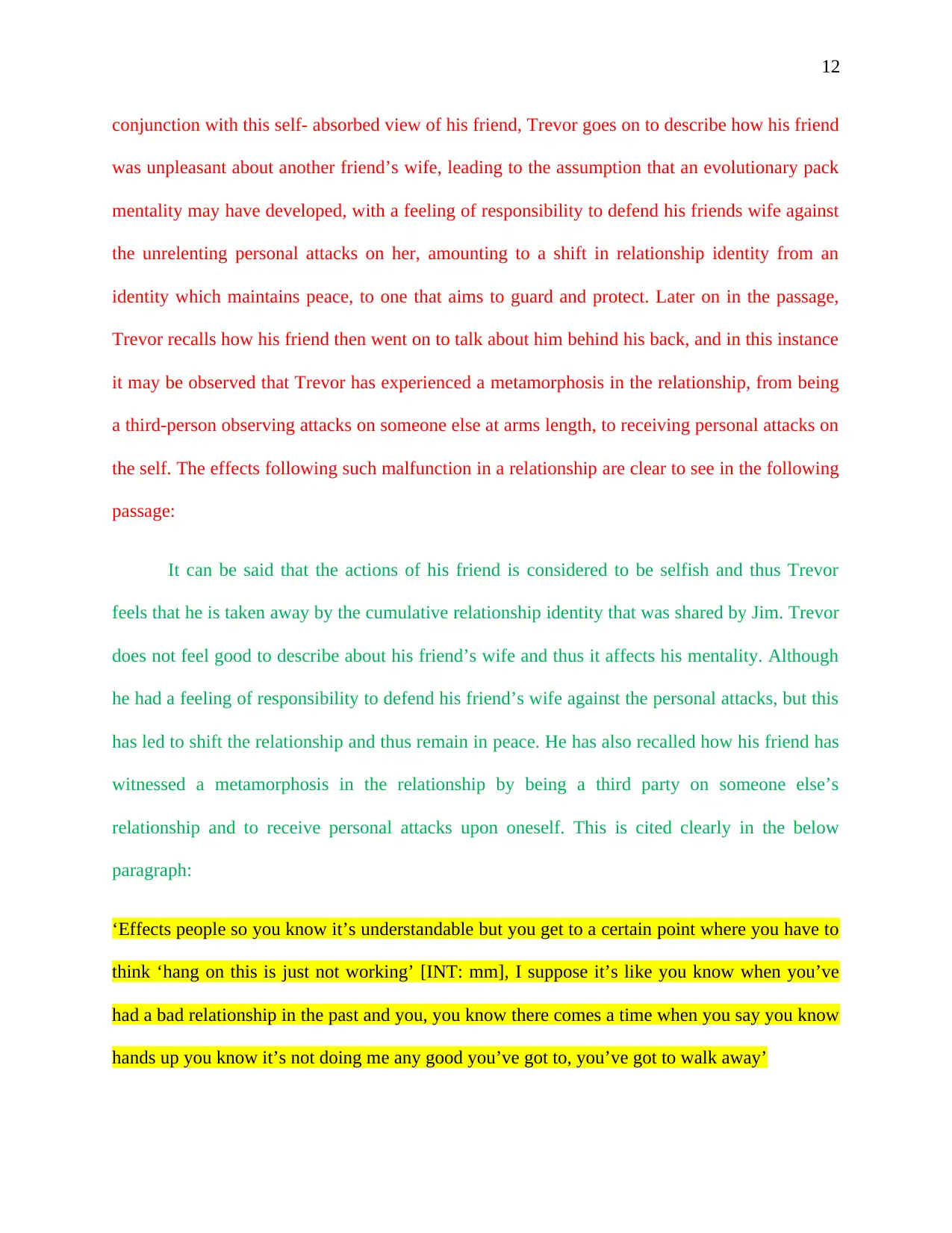
12
conjunction with this self- absorbed view of his friend, Trevor goes on to describe how his friend
was unpleasant about another friend’s wife, leading to the assumption that an evolutionary pack
mentality may have developed, with a feeling of responsibility to defend his friends wife against
the unrelenting personal attacks on her, amounting to a shift in relationship identity from an
identity which maintains peace, to one that aims to guard and protect. Later on in the passage,
Trevor recalls how his friend then went on to talk about him behind his back, and in this instance
it may be observed that Trevor has experienced a metamorphosis in the relationship, from being
a third-person observing attacks on someone else at arms length, to receiving personal attacks on
the self. The effects following such malfunction in a relationship are clear to see in the following
passage:
It can be said that the actions of his friend is considered to be selfish and thus Trevor
feels that he is taken away by the cumulative relationship identity that was shared by Jim. Trevor
does not feel good to describe about his friend’s wife and thus it affects his mentality. Although
he had a feeling of responsibility to defend his friend’s wife against the personal attacks, but this
has led to shift the relationship and thus remain in peace. He has also recalled how his friend has
witnessed a metamorphosis in the relationship by being a third party on someone else’s
relationship and to receive personal attacks upon oneself. This is cited clearly in the below
paragraph:
‘Effects people so you know it’s understandable but you get to a certain point where you have to
think ‘hang on this is just not working’ [INT: mm], I suppose it’s like you know when you’ve
had a bad relationship in the past and you, you know there comes a time when you say you know
hands up you know it’s not doing me any good you’ve got to, you’ve got to walk away’
conjunction with this self- absorbed view of his friend, Trevor goes on to describe how his friend
was unpleasant about another friend’s wife, leading to the assumption that an evolutionary pack
mentality may have developed, with a feeling of responsibility to defend his friends wife against
the unrelenting personal attacks on her, amounting to a shift in relationship identity from an
identity which maintains peace, to one that aims to guard and protect. Later on in the passage,
Trevor recalls how his friend then went on to talk about him behind his back, and in this instance
it may be observed that Trevor has experienced a metamorphosis in the relationship, from being
a third-person observing attacks on someone else at arms length, to receiving personal attacks on
the self. The effects following such malfunction in a relationship are clear to see in the following
passage:
It can be said that the actions of his friend is considered to be selfish and thus Trevor
feels that he is taken away by the cumulative relationship identity that was shared by Jim. Trevor
does not feel good to describe about his friend’s wife and thus it affects his mentality. Although
he had a feeling of responsibility to defend his friend’s wife against the personal attacks, but this
has led to shift the relationship and thus remain in peace. He has also recalled how his friend has
witnessed a metamorphosis in the relationship by being a third party on someone else’s
relationship and to receive personal attacks upon oneself. This is cited clearly in the below
paragraph:
‘Effects people so you know it’s understandable but you get to a certain point where you have to
think ‘hang on this is just not working’ [INT: mm], I suppose it’s like you know when you’ve
had a bad relationship in the past and you, you know there comes a time when you say you know
hands up you know it’s not doing me any good you’ve got to, you’ve got to walk away’
⊘ This is a preview!⊘
Do you want full access?
Subscribe today to unlock all pages.

Trusted by 1+ million students worldwide
1 out of 28
Related Documents
Your All-in-One AI-Powered Toolkit for Academic Success.
+13062052269
info@desklib.com
Available 24*7 on WhatsApp / Email
![[object Object]](/_next/static/media/star-bottom.7253800d.svg)
Unlock your academic potential
Copyright © 2020–2025 A2Z Services. All Rights Reserved. Developed and managed by ZUCOL.





